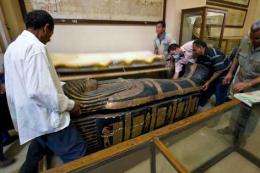The mummy study returns: Scanning of more ancient Egyptians confirms heart disease, finds princess to be oldest case

(PhysOrg.com) -- Although ancient Egyptian royalty didn’t gobble down bacon cheeseburgers or doughnuts dripping with trans fats, smoke cigarettes or spend hours each night in front of the TV, they did share a similar health consequence with people who do these things today: Their coronary arteries were clogged all the same.
A U.S.-Egyptian research team studying CT scans of mummies — a sampling of the elite in ancient Egypt — found that almost half showed evidence of coronary atherosclerosis in one or more of the arteries supplying blood to the heart and brain. The discovery calls into question the perception of atherosclerosis — a buildup of arterial plaque that can result in a heart attack or stroke — as a modern disease.
Additionally, the researchers documented the earliest case of atherosclerosis of the coronary arteries ever recorded. Princess Ahmose Meyret Amon, who was born around 1580 B.C. and died in her 40s, had blockages in two of her three main heart arteries — blockages that could have led to one or more heart attacks. She now represents the first person in human history known to have had heart disease.
“Commonly, we think of coronary artery or heart disease as a consequence of our modern lifestyles,” says Dr. Gregory Thomas, clinical professor of cardiology at UC Irvine and the study’s co-principal investigator. “Our results point to a missing link in our understanding of heart disease, because if this were the case, why would ancient Egyptians with lifestyles so different from ours have atherosclerosis?”
While the American and Egyptian researchers first identified atherosclerosis in a smaller 2009 mummy study, this effort involved whole-body CT scans on 52 mummies housed in Cairo’s Museum of Egyptian Antiquities. Of the 44 with identifiable arteries or hearts, 45 percent had calcifications either in the wall of an artery or along the course of an artery highly suggestive of atherosclerosis.
Most of the atherosclerosis was in the large arteries of the body, including the abdominal aorta, as the investigators had found in 2009. However, the current study determined that key small arteries supplying the heart and brain were also involved. About 7 percent of the mummies had obstructions in their heart arteries, and 14 percent had blockages in the arteries to the brain — the carotid arteries — a leading cause of stroke.
“We found atherosclerosis in the heart and carotid arteries to be much more prevalent than previously imagined,” says co-investigator Dr. Michael Miyamoto, a cardiologist at Mission Internal Medical Group in Mission Viejo and a student in UCI’s Health Care Executive MBA program. “Some of the mummies had evidence of vascular disease that was surprisingly widespread, similar to some of our heart patients today.”
In addition, researchers documented that, similar to now, advancing age was highly predictive of the presence and severity of atherosclerosis. They couldn’t pinpoint the exact cause of death in the mummies, but symptoms consistent with cardiac pain – as accompanies a heart attack – have been described in ancient Egyptian scrolls.
To understand the lifestyles of ancient Egypt’s elite, the team worked with Egyptologists to review risk factors that might have affected the health of their hearts and arteries.
“We suspect — but do not know — that meat was a smaller part of their diet than ours today,” says Thomas, who also directs nuclear cardiology education at UCI. “We know that ancient Egyptians had an overall better diet and were more active, yet they still had the same disease we have. This discovery indicates that we don’t understand atherosclerosis and heart disease as well as we think we do.”
Thomas and his co-principal investigator, Dr. Adel Allam, a professor of cardiology at Cairo’s Al-Azhar University, believe the data suggest that genetic factors are more important in the development of atherosclerosis than previously thought. They caution, however, that a genetic predisposition makes it even more important to carefully manage risk factors that can be controlled to postpone and minimize the disease.
“Recent studies have shown that by not smoking and by keeping blood pressure and cholesterol levels low, calcification of our arteries is delayed,” Allam says. “From what we can tell with this study, humans are predisposed to atherosclerosis, so it behooves us to take the measures necessary to delay it as much as we can.”
“If we live long enough,” Miyamoto adds, “we may all develop some degree of hardening of the arteries. Our goal may well be to die with atherosclerosis and not of it.”
More information: The researchers presented their findings April 3 at the American College of Cardiology’s annual meeting in New Orleans. The study, which appears in the April 2011 issue of the Journal of the American College of Cardiology: Cardiovascular Imaging, was funded by the National Bank of Egypt, Siemens and St. Luke’s Hospital Foundation.
Provided by University of California, Irvine

















